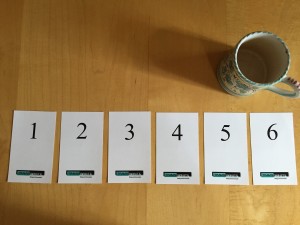Ideas and Free Throws
Assume, for a moment, that I’m your manager. I call you into my office one day and say, “You’re doing pretty good work … but you’re going to have to get better at shooting free throws on the basketball court. If you want a promotion this year, you’ll need to make at least 75% of your free throws.”
What would you do? Assuming that you don’t resign on the spot, you would probably get a basketball, go to the free throw line, and start practicing free throws (also known as foul shots). Like most skills, you would probably find that your accuracy improves with practice. You might also hire a coach or watch some training videos, but the bottom line is practice, practice, practice.
Now, let’s change the scenario. I call you into my office and say, “You’re doing pretty good work … but you’re going to have to get better at creating ideas. If you want a promotion this year, you’ll need to increased the number of good ideas you generate by at least 75%.”
Now what? Well … I’d suggest that you start practicing the art of creating good ideas. In fact, I’d suggest that it’s not very different from practicing the art of shooting free throws.
But shooting free throws and creating ideas seem to be very different processes. Here’s how they feel:
- Shooting free throws – you get a basketball, you walk to the line – 15 feet from the basket – and you launch the ball into the air. You’re conscious of every action. You recognize that you’re the cause and a flying basketball is the result.
- Creating ideas – nothing happens … then, while you’re walking down the street, minding your own business – poof! – a good idea pops into mind. You have no sense of agency. Instead of feeling like the cause, you feel like the effect.
The two activities seem very different but, actually, they’re not. In both cases, you’re doing the work. With free throws, you readily recognize what you’re doing. With ideas, you don’t. Free throws happen in your conscious mind, also known as System 2. New ideas, on the other hand, happen below the level of consciousness, in System 1. When System 1 works up an idea, it pops it into System 2 and you become aware of it.
We understand how to practice something in System 2 – we’re aware of our activity. But how do we practice in System 1? How can we practice something that we’re not aware of?
We think of our mind as controlling our body. But, as Amy Cuddy has pointed out, our bodily activities also influence our mental states. If we make ourselves big, we grow more confident. If we smile, our mood brightens.
So how do we use our bodies to teach our brains to have good ideas? First, we need to observe ourselves. What were you doing the last time you had a good idea? I’ve noticed that most of my good ideas pop into my head when I’m out for a walk. When I’m stuck on a difficult problem, I recognize that I need a good idea. I quit what I’m doing and go for a walk. Oftentimes, it works – my System 1 generates an idea and pops it into System 2.
In my critical thinking classes, I ask my students to raise their hands if they have ever in their lives had a good idea. All hands go up. Everybody has the ability to create good ideas. The question is practice.
Then I ask my students what they were doing the last time they had a good idea. The list includes: out for a walk, driving, riding in a car, bus, or train (but not an airplane), taking a shower, drifting off to sleep, and bicycling.
I also ask them what activities don’t generate good ideas. The list includes: when they’re stressed, highly focused, multitasking, overly tired, overly busy, or sitting in meetings.
So how do we practice the art of having good ideas? By doing more of those activities that generate good ideas (and fewer of those that don’t). The most productive activities – like walking – seem to occupy part of our attention while leaving much of our brainpower free to wander somewhat aimlessly. Our bodily activity influences and stimulates our System 1. The result is often a good idea.
Is that perfectly clear? Good. I’m going for a walk.
Innovation In Our Refrigerator

How can I innovate here?
When we think of innovation, we often think of bright young people working in creatively organized offices while pushing the envelope and thinking outside the box. It’s fun, exciting, challenging, and maybe even a little bit sexy. It’s the kind of job we all want.
But what about the rest of the world?
Much of the innovation that I have observed takes place in rather mundane places and involves rather ordinary business or social processes. It’s the act of taking some thing (or some process), observing how it’s used, and designing a better way to do it. If we think about innovation only as the process of creating something entirely new, we’ll miss many, many opportunities to change the world for the better.
Take our refrigerator, for instance.
Suellen and I were recently on vacation and asked a very responsible young woman named Alyssa to house sit for us. As soon as we left, our refrigerator stopped working. Alyssa organized a service call, coordinated with the repairman, and had the refrigerator repaired in a jiffy. From our perspective, it was virtually painless (except for the bill, of course).
When we arrived back home, we also got a pleasant surprise. Alyssa had completely reorganized the interior space of the refrigerator. She had examined the food items we keep and adjusted shelves and drawers to fit our lifestyle. She used the space much more efficiently and made frequently used items more readily available. It’s now simpler and easier to store and retrieve our food.
Why hadn’t we organized our fridge more effectively? We never thought about it. It’s one of those ordinary, mundane appliances that doesn’t attract our attention. It’s not leading edge, or state of the art, or sexy. Though we use it every day, we never considered how we might improve it. When the refrigerator arrived in our house, we simply put our food in it. We didn’t think about rearranging shelves or drawers to improve utility and efficiency. It took Alyssa to apply design thinking to an ordinary, everyday item.
We describe some things as “wallpaper” because they recede into the background. We don’t need to pay much attention to them. We don’t consider them as opportunities to create and innovate. But we interact with our wallpaper everyday. That makes even small innovations meaningful and impactful. If you want to be an innovator, spend more time on wallpaper and less time thinking outside the box.
Questions or Answers?

Question or answer?
Which is more important: questions or answers?
Being a good systems thinker, I used to think the answer was obvious: answers are more important than questions. You’re given a problem, you pull it apart into its subsystems, you analyze them, and you develop solutions.
But what if you’re analyzing the wrong problem?
I thought about this yesterday when I read a profile of Alejandro Aravena, the Chilean architect who just won the Pritzker Prize. Aravena and his colleagues – as you might imagine – develop some very creative ideas. They do so by focusing on questions rather than answers. (Aravena’s building at the Universidad Católica de Chile is pictured).
In 2010, for instance, Aravena’s firm, Elemental, was selected to help rebuild the city of Constitución after it was hit by an earthquake and tsunami. I would have thought that they would focus on the built environment – buildings, infrastructure, and so on. They’re architects, after all. Isn’t that what architects do?
But Aravena explains it differently:
“We asked the community to identify not the answer, but what was the question,” Mr. Aravena said. This, it turned out, was how to manage rainfall, so the firm designed a forest that could help prevent flooding.
Architects, then, designed a forest instead of a building. If they were thinking about answers rather than questions, they might have missed this altogether.
On a smaller scale, I had a similar experience early in my career when I worked for Solbourne Computer. We build very fast computers – in 1988, Electronics magazine named our high-end machine the computer of the year. Naturally, we positioned our messages around speed, advanced technology, and throughput.
But our early customers were actually buying something else. When we interviewed our first dozen customers, we found that they were all men, in their early thirties, and that they had recently been promoted to replace an executive who had been in place for many years. They bought our computers to mark the changeover from the old regime to the new regime. They were meeting a sociological need as much as a technical need.
When you go to a gas station to fill your car’s tank, you may imagine that you’re buying gasoline. But, as the marketing guru Ted Levitt pointed out long ago, you’re really buying the right to continue driving your car. It’s a different question and a broader perspective and may well lead you to more creative ways to continue driving.
More recently, another marketing guru, Daniel Pink, wrote that products and services “… are far more valuable when your prospect is mistaken, confused or completely clueless about their true problem.” So often our market research focuses on simple questions about obvious problems. The classic question is, “What keeps you up at night?” We identify an obvious problem and then propose a solution. Meanwhile, our competitors are identifying the same problem and proposing their solutions. We’re locked into the same problem space.
But if we step back, look around, dig a little deeper, observe more creatively, and ask non-obvious questions, we may find that the customer actually needs something completely different. Different than what they imagined – or we imagined or our competitors imagined. They may, in fact, need a forest not a building.
Rabies and Burglaries

Architect or burglar?
Long-time readers of this column know that I’m an advocate of mashup thinking. You take an idea from Column A and an idea from Column B and mash them together. So, for instance, X-rays (Column A) when mashed up with computerized image processing (Column B), yield an important new product called CT scanners.
A good way to brainstorm is simply to mash up ideas from different categories. You’re not thinking out of the box. Rather you’re thinking out of multiple boxes. What would you get if you mashed up, say paper with pasta? Would it be edible paper? Or maybe pasta that you could print messages on? Would it be useful? Maybe. Maybe not. What’s useful is the process of getting there.
So, I was delighted to see that the Museum of Contemporary Art (MCA) in Denver has started a program called Mixed Taste. MCA describes the program as Tag Team Lectures On Unrelated Topics. The idea is simple – they choose two topics (seemingly out of thin air) that are completely unrelated. Then they get speakers to speak on each topic. They rent an auditorium, get a band, invite the public, and have at it.
Last night, the topics were rabies and burglary. I thought of these as two completely unrelated topics but, when you mash them up, you get some surprises. And that’s the point.
At the event, Monica Murphy and Bill Wasik spoke first. They’re good Brooklynites and also the authors of Rabid: A Cultural History of the World’s Most Diabolical Virus. Here are some things you might not know about rabies.
- It doesn’t travel through the blood but through the nervous system. So it outflanks the blood-brain barrier and heads for the brain.
- It “wants” to get to your brain so it can change your behavior. Most importantly, it wants to stop you from drinking water, an activity that would weaken the virus. Thus, rabies victims develop hydrophobia, an extreme reluctance to drink water. (Here’s another virus that changes your behavior).
- It’s been with us for a long time and it’s almost always fatal.
Geoff Manaugh, an architect who created the popular BLDG|BLOG, spoke next. Manaugh also has a book that will launch next spring called, A Burglar’s Guide To The City. Manaugh pointed out that architects are enablers of burglars. Burglars couldn’t operate without built environments. Architects may think they’re building useful or inspiring structures but they’re also creating a playground for burglars. A good burglar can identify patterns in buildings and use them to locate vulnerabilities. Burglars are often avid students of architectural codes.
So what’s the similarity here? The one I took away is this: Burglars are to buildings as rabies is to humans. Here are some similarities:
- Both take structures (buildings, the human body) developed for one purpose and twist them to their own ends.
- Both have evolved the ability to avoid or overcome sophisticated security measures.
- Both spread in similar ways. A rabid animal creates additional rabid animals. A burglar creates additional burglars.
- Both evolve and adapt to changing situations.
I never would have thought of these similarities if MCA hadn’t mashed them up for me. I found it fascinating. But is any of it practical or useful? I’m not sure … but perhaps we can adapt the techniques we use to control viruses to also control burglars (or vice-versa). But even if that’s not the outcome, we’re practicing the art of mashups — an intriguing thinking process that can produce surprising insights and innovations. For that, I thank the MCA.
(By the way, Monica Murphy, Bill Wasik, and Geoff Manaugh are all very good speakers and I recommend them highly to you).
Equal Opportunity Idea Generation

Pick a card.
At the beginning of each term, I give my critical thinking students a set of six cards. Each card has a number on it – one through six. (I also add my logo to do a little low-cost branding).
Students bring the cards to each class. I use them to guide discussions about topics where there is no obvious right answer. I ask a question with up to six alternative answers. I then ask the students to select the “best” answers and — when I give a signal – to hold up the number that represents their choice.
The trick is to do it simultaneously. Then I say something like, “Jamal, you’re holding up number six and Carmen is holding up number three. Let’s discuss why you’ve chosen different answers.” This often leads to some very robust discussions. Nobody hides and everyone knows that they may be asked to explain their opinion. If you mix in a little humor, it can also be a lot of fun.
I call these equal opportunity discussions. In most discussions, I find that whoever speaks first exerts undue influence on every subsequent speaker. It’s a phenomenon called social convergence and it’s impossible to eliminate unless you have everyone “speak” simultaneously. With simultaneous responses, everyone has an equal opportunity to get their idea across.
I first used this system during the merger of Lawson, an American software company, and Intentia, a Swedish software company. Both companies had about 2,000 employees. They also had different national traditions and corporate cultures. Every employee had an opinion about what the new company culture should be. The question for managers (including me) was: how do we gather, weigh, and merge these opinions?
We decided to use equal opportunity discussions focused on how the new culture would respond to different behaviors. For instance, in a meeting with up to a dozen employees, we might ask a simple question: “Klaus is always late to staff meetings. In our new company culture, what do you think Klaus’ manager should do?” We included a list of up to six answers. We asked the employees to consider the answers and then hold up her or his chosen answer simultaneously. This produced some very spirited discussions.
We kept track of how different groups answered each question. Did marketers answer the questions differently than, say, engineers? How about executives versus individual contributors? It took time but it was very valuable information that ultimately led to a coherent new culture.
A similar technique works well in promoting innovation. The first step is to gather a wide range of diverse ideas. Letting one person speak first (especially the boss) will reduce diversity. When I ran staff meetings focused on creating new ideas, I would frame up the issues several days in advance. I asked each participant to consider the issue and develop his or her best ideas. I then asked them to write down their ideas – no more than a paragraph or two. When we got to the meeting, I asked everyone to push their written descriptions to the middle of the table. I then gathered them up, shuffled them a bit, and started the discussion.
I thought about these processes when I spotted a recent article in Harvard Business Review titled, “People Offer Better Ideas When They Can’t See What Others Suggest.” The context is slightly different – the authors are looking at programs like Dell’s Idea Storm site or the My Starbucks Idea site.
Though the context is different, the process is essentially the same. The authors write that, “The trick is to avoid clustering, where the same people have the same experiences.” They also created anti-clustering software that ensures “…that no participants share the same body of ideas and the same neighbors as anyone else.”
I’m sure the anti-clustering software is more sophisticated than my cards. But if you want to get off to a quick start, the cards work pretty well. Just make sure that every idea has an equal opportunity to “win”.
